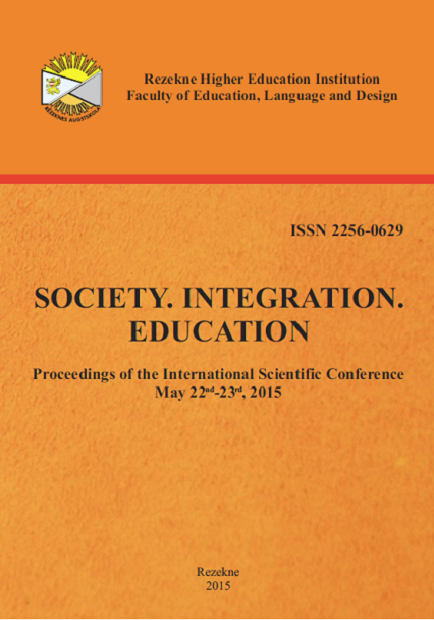Maritime Labor Market Demand and Career Path in Latvia
DOI:
https://doi.org/10.17770/sie2015vol1.309Keywords:
maritime, employment, career path, higher educationAbstract
Seafaring profession has traditionally been considered a romantic profession among young people, but in today’s labour market has dramatically changed priorities of career choices. At present, the maritime industry has more than 40 thousand vacancies, in addition to the growing trend - the shipping officers with University level are particularly difficult to recruit for crew shipping companies.
The methodology: an analysis of policy documents, statistical data analysis, a secondary analysis of previous research, database analysis, surveys. The motives of choosing profession of young people were determined by economical (good salary, possibility to maintain family welfare, career possibilities and etc.), social (wish to acquire education, seafarers are valuated as specialists, and etc.) and psychological (seafarer’s work seemed to be very interesting, dream to become a captain, and etc.) factors. Both external and internal factors predetermine the choice of seafarer’s profession.
The conclusion can be done that maritime education and training institutions have to explain young people all merits of maritime profession and show possibility for them to find emotional attractiveness and realization of their interests if they choose maritime professions.
References
Alderton, T., Winchester, N. (2006). Globalisation and de-regulation in the maritime industry. Marine Policy, Vol. 26, pp. 35-43.
Bailey, T. (1991). Jobs of the futur and the education they will require: Evidence from occuational forecast. Educational Researcher, 20(2), p. 11-20.
Belcher, P., Sampson, H., Thomas, M., Veiga, J., Zhao, M. (2003) Women seafarers. Global employment policies and practices. Geneva: International Labor Office.
Benito, G. et. al. (2005). A cluster analysis of the maritime sector in Norway. International Journal of Transport Management, Vol. 1, pp. 203–215.
Berden, K.G., Francois, J., Tamminen, S., Thelle, M., Wymenga, P. (2009). Non-Tariff Measures in EU-US Trade and Investment an Economic Analysis. Rotterdam: ECORYS Nederland BV. Source: http://ntm.ecorys.com/images/downloads/ntm_book_final.pdf [Skatīts 16.03.2015.]
BIMCO (2010). Manpower 2010 update.
Bloor, M.; Michelle, T.; Tony, L. (2000). Health Risks in the Global Shipping Industry: An Overview, Health, Risk & Society, 2(3), pp. 329-340
Corres, A. J. (2007). Greek Maritime Policy and the Discreet Role of Shipowners’ Associations. Research in Transportation Economics, Vol. 21, pp. 221–255.
European Commission (2011a).Report of the Task Force on Maritime Employment and Competitiveness and Policy. http://ec.europa.eu/transport/modes/maritime/seafarers/doc /2011-06-09-tfmec.pdf [Skatīts 01.09.2014.].
European Commission (2011b). Study on EU Seafarers Employment. Final Report.http://ec.europa.eu/transport/modes/maritime/studies/doc/2011-05-20-seafarers-employment.pdf. [Skatīts 01.09.2014.].
Gailitis, R. (2013). Assessment of contribution of maritime education institutions in Latvian seafarerspool. Journal of Maritime Transport and Engineering, Vol.2 (1), pp.4-12.
Gailitis, R., Fjodorova, A. (2014). Determination of Parameters to Model Seafarers’ Supply in Latvia. The International Journal on Marine Navigation and Safety of Sea Transportation, Vol. 8 (2), pp. 245-252.
Gailitis, R., Jansen, M. (2012). Development of the Latvian Maritime Policy; A Maritime Cluster Approach. The International Journal on Marine Navigation and Safety of Sea Transportation, Vol. 6 (2), pp. 287-292.
Glen, D. (2008). What do we know about the labour market for seafarers? Marine Policy, Vol. 32, pp. 845-855.
Guļāns, P. (1999). Kuģu virsnieku sagatavošanas ekonomiskā efektivitāte Latvijā. Riga: Latvian Maritime Academy.
International Maritime Organisation (2008).“Go to Sea!”IMO official web page: http://www.imo.org/ourwork/humanelement/gotosea/Pages/Default.aspx (skatīts 05.09.2014)
Kent, T. (2013).Global Marine Trands 2030. London: Lloyd’s Register Group Limited, Hampshire: QinetiQ, Glasgow: University of Strathclyde
Latvijas Jūrniecības gadagrāmata 2012, (2013), Riga: Latvian Maritime Administration, p.100-171.
Li, K., Wonham, J. (1999)A method for estimating world maritime employment. Transportation Research Part E 35, pp. 183- 189.
Magramo M., Gellada L. (2009). A Noble Profession Called Seafaring: the Making of an Officer. TransNav, the International Journal on Marine Navigation and Safety of Sea Transportation, Vol. 3, No. 4, pp. 475-480
Mitrossi, K. (2004). “The ship owners’ stance on third-part ship management: An empirical study”, Maritime Policy and Management, 31(1), pp. 31-45.
Mitroussi, K. Employment of seafarers in the EU context: challenges and opportunities. Marine Policy, Vol. 32 (6), 2008, pp. 1043-1049.
Moreby, D.H., Springett, P. (1990). The UK shipping industry: Critical levels study. London: British Marine Charitable Foundation
Pettit, S. et. al. (2005). Ex-seafarers shore-based employment: the current UK situation. Marine Policy, Vol. 29, pp. 521-531.
Shinohara, M. (2010). Maritime cluster of Japan: implications for the cluster formation policies. Maritime Policy & Management, The Flagship Journal of International Shipping and Port Research, Vol. 37, pp.377-399.
Sornn‐Friese, H., Hansen, C. Ø. (2005). The Blue Denmark: Is it a maritime labour mobility cluster? Copenhagen: Center for shipping economics and innovation.
Stopford, M. (2008). Maritime Economics, Routledge, 2008.
Study on EU Seafarers Employment. (2011), Brussels: European Commission.
The Mapping of Career Paths in Maritime Industries.(2005). Southampton Solent University.
Wagtmann, M. A., & Poulsen, R. T. (2009). Recent Developments and Probable Future Scenarios Concerning Seafarer Labour Markets. In MET Trends in the XXI Century: Shipping Industry and Training Institutions in the global environment - area of mutual interests and cooperation. (pp. 306-23). International Organisation of Maritime Universities.
Wu, B., Winchester, N. (2005). Crew study of seafarers: a methodological approach to the global labour market for seafarers. Marine Policy, Vol. 29, pp. 323–330.






